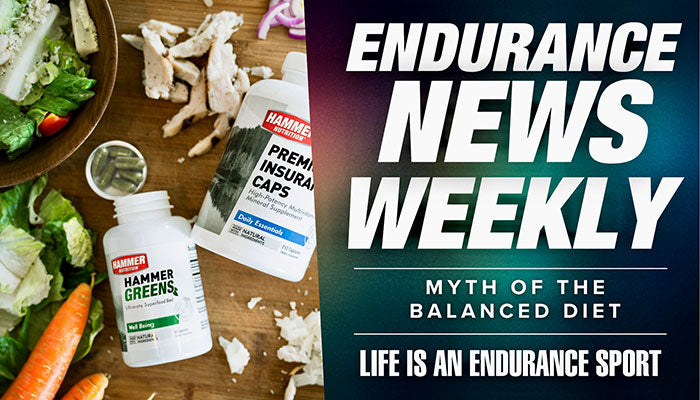
PREFACE BY BRIAN FRANK
The last two issues of ENW provided Dr. French and my take on the “new” idea of high carb fueling and the science behind the recommendations of 90-100 grams, or more of carbs per hour that we hear is all the race among pro tour teams in Europe. Based on the number of comments, both pro and con, as well as the feedback we’ve been fielding via other channels recently, we’ve struck a nerve. A common theme coming from critics is that Hammer is not following current science and not keeping up with the trends in fueling. Others have taken the two part series as if it was written in a vacuum and not in context of what I have been saying for decades.
So, before we continue the discussion about hi carb fueling and why it’s a bad idea for everyone, we’re going to go back and re-visit another instance where science was very convincing, until it wasn’t.
Enjoy the read and keep the feedback and comments coming!
---
The SCOOP on Sugar
By Dr. Bayne French
First published in Endurance News Issue 117
Although much has been written in EN over the years about sugar, I want to throw in my two cents. In my medical training, I was never taught about the detrimental health effects of sugar. But in defense of medical education, I was taught a lot about the human body, diseases, and medicine. What I know about health and nutrition, I learned from chiropractic school, my mother, and my own reading.
Nutritional science is tough. The crux being the difference between association and causality. As a case in point, American male meat eaters have a high rate of heart disease. But is it the meat? Or is it perhaps abdominal obesity, deconditioning, smoking, high sugar consumption, or a myriad of other influences and contributors to inflammation? Food questionnaires and other data-gathering tools are relatively easy, but a true medical experiment like randomized controlled trials is much more involved and expensive.
What about bias and outright duplicity? The Sugar Research Foundation (SRF) funded “research” and Ancel Keys’ famous “research” in the ’50s and ’60s directed outcomes to meet their conclusions—not exactly the scientific method. The detrimental effects of sugar on cardiovascular health were minimized and fat was demonized. These results dramatically changed the landscape of nutritional advice and spawned the high-carb, low-fat dietary recommendations we are still reeling from today.
Dr. John Yudkin, a British physician, warned about sugar’s effects on cardiovascular disease. He wrote Pure, White, and Deadly in 1972 and urged public health campaigns to focus on sucrose. How many of you have even heard of him? He’s not alone.
There are numerous sources and studies as early as the ’50s focused on sugar’s health detriments. The emerging evidence led the SRF to construct its research and pay Harvard researchers to shift the focus from sugar to fat. That’s enough to raise my blood pressure.
Tufts University performed research, compiling a massive amount of data on sugar-sweetened beverage (SSB) consumption that many feel reflects causality between sugar and obesity, heart disease, type 2 diabetes, and cancer. These findings were published in Circulation in 2015. They report that, worldwide, 184,000 DEATHS per year are directly attributable to SSB consumption: 133,000 from diabetes, 45,000 from cardiovascular disease, and 6,450 from cancer. They concluded the data was “indicating an urgent need for strong global prevention programs.”
I say stop buying it, stop consuming it. But what is “it”? Soda, of course, and most sports drinks, but I would include juice and milk too. Artificially sweetened beverages must certainly be better, right? Blood pressure going up. Well, maybe in a future article.
True sugar is sucrose, a disaccharide, which is 50/50 glucose and fructose. High fructose corn syrup is 75% fructose. Although all cells in the body can metabolize glucose, only the liver processes fructose, and there is no more potent driver of fat formation (lipogenesis) than fructose. What about fruit? Worry not! Just chew it, don’t drink it.
I enjoy endurance activities and have been accused of some outlandish pursuits replete with suffering and loss of sphincter tone.
Usually, I exercise on an empty stomach, but for races or longer training sessions, I fuel with a complex carb. I know of no head-to-head quality study comparing a more complex carb like maltodextrin to a refined carb like sugar in regard to performance, inflammatory markers, recovery, etc. What is known is that maltodextrin has significantly lower sugar content, and it makes intuitive sense to me that there would be less metabolic perturbation.
As a physician with a great interest in leanness, wellness, and disease prevention, I feel there is absolutely, no place for sugar in the achievement of these things. So often I see wiry, lean, high-sugar-consuming outdoor savages with their first heart attack in their 50’s. I also commonly see sugar-eating endurance freaks who think the rules of biochemistry don’t apply to them because of their fitness.
These individuals frequently exhibit the classic sugar-eating triad: insulin resistance/prediabetes, low HDL (an independent risk factor for heart disease), and high triglycerides. These are the same results found in obese patients with diabetes and heart disease. So I feel that sugar in all forms should be consumed next to never.
---
Another Scoop On Sugar
By Dr. Bayne French M.D. D.C.
First published on ENW, June 2 2021.
Continued from Endurance News #117
There is something special about sugar, beyond its heavenly taste. It seems that sugar is capable of doing things that other sources of carbohydrates just can’t pull off. It’s so special in fact, that it’s “toxic,” according to researcher Dr. Robert Lustig. He concluded that sugar has dramatic detrimental effects on metabolic health irrespective of calories or changes in weight.
In a 2015 study originally published in Obesity, and later in TIME magazine, Dr. Lustig simply replaced, calorie for calorie, all the sugar that a group of adolescents ate with starch. Yes, you read this correctly. They replaced sugar carb with complex, starchy carb. The results were alarming. These adolescents lost weight, they went from insulin resistant to insulin sensitive, and had much less fat in their liver. Lustig states, “We gave them crappy food, shitty food, processed food-and they still got better. Imagine how much even better they would have gotten if we didn’t substitute, and took sugar out.”
Prior to this, many studies established correlation between sugar and metabolic disease; many feel this study proves causation. Sugar IS special, in a sinister, toxic kind of way.
I have observed similar findings in my adult patients. Athletes who fuel with simple carb/sugar show similar laboratory results to obese, poorly controlled diabetic patients: Elevated blood sugar and insulin levels, high triglycerides, low HDL (favorable cholesterol), small and dense LDL (bad cholesterol) particles, and high CRP (inflammatory marker).
As discussed in “The Scoop on Sugar” in EN #117, sugar (sucrose) is made up of glucose and fructose in equal amounts. High fructose corn syrup has 75% fructose. Every cell in our body can metabolize glucose, but only the liver can process fructose. Sugar hits the bloodstream like a freight train, stimulating the liver to produce fat in a process called lipogenesis. I’m told foie gras (made from over-fattened duck’s liver) is delicious, but it’s not a healthy situation for the ducks, and same goes for us.
Another interesting observation I’ve made over the years in sugar eaters and drinkers who are lean is that they can have isolated liver enzyme elevations. Their blood sugar and cholesterol profile may be normal, yet their liver is inflamed despite low levels of alcohol consumption. A liver ultrasound report commonly states “increased echogenicity, suggestive of steatosis.” Fatty Liver Disease. I read recently where this practice of feeding ducks and geese large amounts of carb to form yummy fatty liver is now considered inhumane in the culinary world. I don’t disagree, but it’s hard not to laugh, as many people do it to themselves at every meal, snack, and training session. Here I go…I’m coining it…FGISEAS (Foggy Seas)—Foie Gras In Sugar Eating Athletes Syndrome.
Let’s talk about immune function for a moment. I can remember my mother saying “if you eat that you’re gonna catch a cold” in reference to some next-to-never sugary treat I had access to in my strange upbringing. What a smart lady. Many articles reference a 1973 study published in The American Journal of Clinical Nutrition, where immune function was measured after sugar consumption. Phagocytosis is a process where white blood cells literally engulf microbial invaders (viruses, bacteria, fungi). They have a zero tolerance policy for outsiders, which makes them the O.X., Original Xenophobes. Blood was drawn from a willing participant multiple times after consuming some sugary crap. Their blood was then incubated with Staphylococcus epidermidis, a bacteria that commonly lives on our skin. The “phagocytic index,” which is the number of bacteria observed within each white blood cell, was then measured. The decrease in the phagocytic index was rapid following the ingestion of simple carbohydrates. The effect was greatest 1–2 hours after sugary nastiness was consumed but extended for at least 5 hours. The number of white blood cells was not reduced; only their function was impaired.
There were two other very interesting observations:
1. This impaired immune function was seen only with consumption of simple carbohydrates like glucose, fructose, sucrose, and orange juice. Longer chain, complex carbohydrates did not have this effect.
2. Fasting for 36 hours or more significantly increased the phagocytic index (refer to EN #123 and #124 for my two articles on intermittent fasting). Now more than ever I want my white blood cells to phagocytize basically anything that moves.
And then there’s heart disease. What is worse than heart disease? Dying from heart disease. Most previous studies focused on sugar-sweetened beverages and their effect on weight gain, obesity, distorted cholesterol, type 2 diabetes, high blood pressure, and cardiovascular disease (CVD). JAMA Internal Medicine looked at total sugar consumed (solid and liquid) and the risk of actually dying from CVD, using data collected via NHANES (National Health and Nutrition Examination Survey). This is a series of surveys of the US population that in 1999 became a continuous program. It consists of a comprehensive interview and a physical examination of each survey participant.
Added Sugar Intake and Cardiovascular Diseases Mortality Among US Adults
This study was comprised of two components:
-
Analysis of total sugar consumption
-
The association of this consumption with CVD mortality (becoming dead)
Over 30,000 individuals were included in this study over the course of decades and it became pretty apparent that to enhance your probability of remaining undead, super minimization of sugar is advisable.
There is no universally accepted guideline for limiting added sugar consumption. The World Health Organization (WHO) recommends that less than 10% of daily calorie consumption should be from added sugar. The Institute of Medicine recommends that no more than 25% of your daily calories should be from added sugar. A quarter of our daily caloric consumption from added sugar? Are these people serious? Are we being punked? At least there is the strong verbiage “no more than!” One can of soda contains about 35 grams of sugar, so if you consume about 2000 calories per day, make sure you consume “no more than” 4 cans of soda per day. One sip more and you’re done for!
I know what you’re thinking, ”So what did the study show, ‘Frenchy,’ you desk-pounding fanatic!?” Participants who ate or drank sugar greater than or equal to 10% but less than 25% (the level below the Institute of Medicine recommendation and above the WHO recommendation) had a 30% higher risk of dying from CVD. Yes there’s supposed to be a 0 after that 3. And for those who thumbed their nose at the generous Institute of Medicine recommendations and consumed more than 25% of their calories from added sugar, their risk was nearly tripled. Maybe there are a few regular exercisers out there reading this. And maybe you’re thinking the rules of biochemistry somehow don’t apply to you because you just “burn it off.” Well unfortunately the observed association between sugar and dying was consistent across age, gender, race, educational levels, weight, and physical activity levels.
I consider the evidence irrefutable: sugars (meaning all simple carb sources) are not benign substances, even though our brain drives us to seek them out. Patients with diabetes, whose blood sugar is chronically elevated, have a dramatic increase in disease burden, including infections. But the consequences from repetitive blood sugar spikes following a soda, sports drink or sugary snack cannot be discounted. Dr. Lustig showed that sugar had particular nasty metabolic effects on young people that longer chain, complex carb sources just did not. And in the early 1970s simple sugar carb sources, not complex carb sources, were shown to directly inhibit our immune system’s ability to kill germs. Enjoying one’s diet is paramount, and I’m not a zealot, but choosing to reserve your dietary and exercise carb choices to quality, organic, and complex sources makes very good biological sense to me. I see people every day who have lost the ability to move their bodies. This glorious act many of us take for granted is lost to them. It behooves us fortunate souls that still possess this gift, and regularly do it at exhaustive levels, to eliminate the ingestion of disease-promoting toxic sugar. The healthiest people I see have demoted sugar from a staple to an occasional garnish. And that’s what I try to do.
References available upon request










4 comments
I’m alarmed at how many people are scope-locked on the kind of “nutrition science” that also brought us the food pyramid; maybe I shouldn’t be surprised, but I can’t help it. I started questioning that in earnest about five years ago, and in research since, the one outstanding villain that turned up over and over was sugar (and worse, HFCS). The only “foods” worse were food additives so carcinogenic, they were banned. I was 50lbs overweight coming out of high school because of increasing soda consumption, but Thank God, I identified sugar as the problem and took steps to limit it. Now, as I delve deeper into metabolism and mitochondrial function, I recognize that not only are the recommendations for massive sugar consumption damaging, so are the suggestions that runners consume 60-70% carbs. The performance benefits of that are overstated and the long-term consequences ignored, but one thing’s become clear to me: assuming there are performance benefits, they are ABSOLUTELY NOT WORTH IT.
I can’t help responding to this and your recent, “controversial” articles, because far too many athletes need to listen, step back, and do the kind of serious diet and health evaluation I did. One thing that’s occurred to me: when you break the high-carb (and especially high-sugar) cycle, you experience something I imagine is similar to alcohol or drug detoxification. Sugar acts on the brain’s reward centers similar to opioids – in fact, most carbs do. Similarly, the unrelenting consumption of carbs from cradle to grave the average westerner engages in basically shuts down many processes critical to maintaining a healthy metabolism and immune system – it promotes heart disease, diabetes, cancer, and a host of other avoidable chronic ailments. And yet how many athletes even try to make a change? How many do a week or two of the latest fad, see a performance drop, and declare the high-carb path to be the only one? It’s like giving up cocaine for a week, saying “well, that sucked” and going right back. Only in this case, the “drug” is one your body has been conditioned all its life to work off of.
I’m not a professional athlete and I can’t say that you can shift to a >50% fat (caloric intake) diet with no loss of performance if you commit long enough (it would be a long-term commitment, I acknowledge) – BUT IT’S WORTH A TRY. Replacing even 100g of those empty carbs with high-quality fats (or even that and whole fruits and vegetables) could stave off serious health consequences for a decade or more. Well, unfortunately, this is turning into quite an editorial. The thing is, I greatly appreciate Hammer – for turning me onto a lot of things that were novel concepts to me at first, but that I keep finding independent confirmation for over the years – and the willingness to forgo short-term sales and instead emphasize total nutrition and health. I’m just one little voice, but I hope the nay-sayers will at least take a minute, set aside their nutrition dogma, and learn what the long-term outcomes of their current diet are. Turns out Grandma probably knew more than all those professional nutrition coaches when she said [of healthy eating] “if it tastes good, spit it out!”
Curious how the body responds to sugar substitutes such as Splenda, Equal, and Stevia. Especially Splenda since a primary ingredient maltodextrin is also a primary ingredient in Hammer Gel and Recoverite.
———
Hammer Nutrition replied:
Hello Michael, not sure I can follow you here, but sounds like you are trying to get me with a “gotcha” question. Stevia is a natural sweetener that comes from a plant in south America and cannot be lumped in with chemically manufactured artificial sweeteners like splenda, equal or aspartame. Stevia It has no side effects nor negative impacts on human metabolism. The same cannot be said for the others and that information is widely available. Splenda is made from smashing sugar and chlorine (like you put in your pool) together to create a hyper sweet, un-digestible, zero calorie “sweetener” that is then added to dextrose and maltodextrin to “bulk” it up because otherwise the serving packet would be nearly completely empty. We use large volumes of corn and tapioca derived maltodextrin in these products as a source of calories – a preferable option to any form of “ose” sugar. BDF
This article does not address the question regarding the level of fuelling during an endurance event. High carb fuelling in competition has nothing to do with the studies you have mentioned of every day consumption of sugars. Furthermore, I find it very unscientific to use the charlatan Dr Lustig as a reference for your scientific support for a non-sugar approach. Dr Lustig picks reads the scientific literature as the devil reads the bible to support his approach. I am definitely not a proponent of fast carbohydrates, but I was reading this to evaluate your position on high carb fuelling during events.
———
Hammer Nutrition replied:
Hello Anna Catharina, talk about a blast from the past – You and Steve had some long discussions on similar topics decades ago. Anyway, it seems you missed the point of this article and perhaps did not read the previous two weeks of ENW where we discussed in great detail why high sugar fueling is a really bad idea. I’m glad we agree on fast/sugar carb sources for fueling. By point in publishing this article was to point out that science is not perfect and can and has been manipulated in the past, as it is now. Your criticism of Dr. Lustig is without merit or substance. His new book Metabolical is a tour de force like no other, laying bare the truth about sugar and processed foods being THE cause of our health crisis. We’ve not finished discussing this issue, so stay tuned for upcoming issues. BDF
I’m 100% with you. Been an endurance athlete for 25+ years. Stick to your guns!